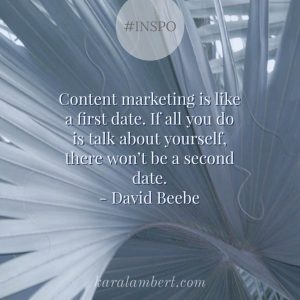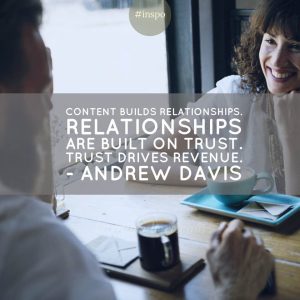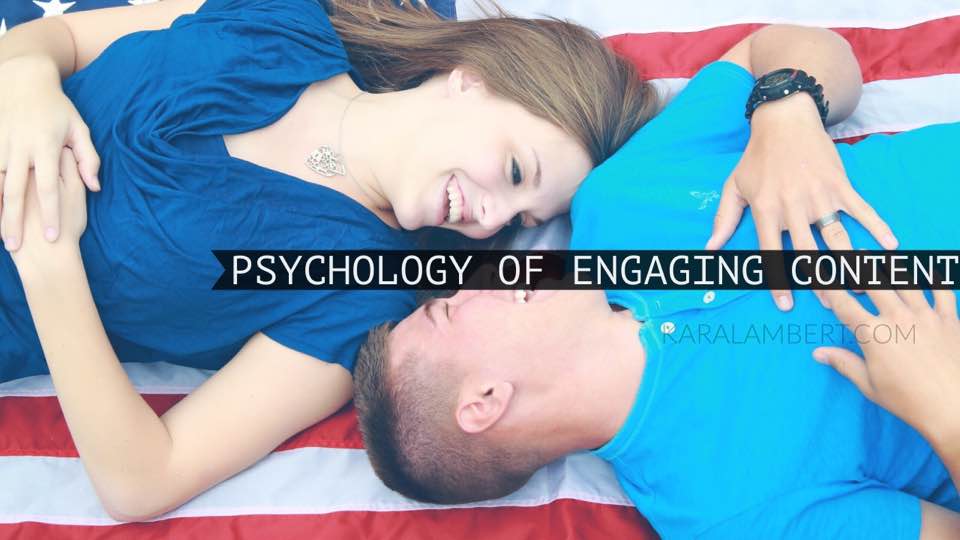“Kara! How do I get more likes comments or shares on my Facebook?” This is one of the most commonly asked questions I receive. Essentially, how do I increase Facebook engagement? Most people ask about Facebook engagement because that’s where they hang out. On occasion I’m asked about Instagram engagement and that’s generally the same answer. (And it’s not, I don’t know)
My usual response to wanting increased engagement is the following:
People want to be educated, entertained, or inspired. Do that and ask for the engagement.
Sadly, most businesses are still in the ‘buy my shit’, ‘we are so great’, ‘share and win’ mentality. Now, I maintain that part of that is not knowing any different and part of it is old school marketing in new school technology. The thing is that some business owners are looking for more information on how to improve and they are following, reading, and studying – which is great – but it generally leads to more of the same.
So what have I done differently about engaging social media content?
Anyone who knows me well will know I’ve looked at some research. That’s my thing. I want to know the why behind things. And of course, it’s some psychological research because – PEOPLE.
I will keep coming back to that point again and again.
Social media is a tool to PEOPLE use to connect.
Sadly, I feel businesses are lost in the technology and have lost sight of the people actually using the technology.
So let’s start with the people and how they see brand content
The information in this article is taken from research by Ashley & Tuten (2015) and their analysis of previous research and study of the top 100 branded companies according to Interbrand’s Best Global Brand survey.
The research looked at why consumers use social media. By and large, we use social media to build ‘social capital’, feel better, and communicate to meet our need to be sociable. The team go on to say that our need to communicate falls into 3 categories: around a topic, around a relationship, and around ourselves. Studies have shown that on Facebook, consumers use Facebook to ‘consciously portray images about themselves’.
 The other thing that they discovered was that when a ‘consumer’s knowledge about a brand increases (through social media) so does the emotional attachment to the brand’ and this is regardless to the type of content a brand posts on social media.
The other thing that they discovered was that when a ‘consumer’s knowledge about a brand increases (through social media) so does the emotional attachment to the brand’ and this is regardless to the type of content a brand posts on social media.
However, they mention that engagement is dependent on the consumer’s needs, motives & goals. Their engagement is important as consumers are not on social media just to absorb information, they’re also there to be educated, entertained, or inspired. Unfortunately, brands suffer if the consumer believes that the relationship is one-sided or if it does something that does not match how the consumer sees them and the brand’s identity.
What makes good engaging content?
Consumers can engage with content which falls into one of five categories: values, resources, time/geography, impact, and their goal for engagement (what they want out of a brand). Most of the time, content delivered by brands is ‘form’ or what the service or product is.
Researchers found that consumer values driven content works best for emotionally driven purchases and for consumers who do not, currently, have a strong relationship with the brand. This content could also be considered as image-driven, where brands meet the desired image of their consumers. This matches where I say that customers use social media to be inspired and relies on a deep understanding of customer values.
This emotional content was also found to be more likely to give an emotional reaction. In Facebook, that would mean that this content would be more likely to receive a Reaction (like, laugh, heart etc) rather than a comment or a share.
On the other end, researchers have found that ‘cognitive engagement’ and ‘functional’ posts, the responses which take a bit more thinking, are related to logical or problem-focused situations and will have a greater impact on consumers who have a closer and more interactive relationship with a brand.

It was interesting to read that consumers were more tolerant of advertising that appeared in games online than they were to ads which appeared on social media. For businesses using the Facebook Ads platform, my suggestion is to include ‘Audience Network’ when setting the placement for the ad.
When looking at the research around Facebook, researchers found that there were only 3 post types which truly drove engagement: image, exclusivity, and incentive. Based on the information above, it means that businesses need to have more posts that align with the values and image the consumer wants to portray on Facebook, that they value exclusivity and they want to receive some incentive to engage on Facebook. The researchers point out that this matches the overall culture of Facebook with our sanitised profiles, desire to have something someone else doesn’t/be the first, and ‘share to win’. A word of warning, remember that it needs balance and that consumers are put off if they feel the relationship is one sided; for example you will lose them if all you post is ‘share to win’, not to mention that you’ll attract people who want freebies.
As stated earlier, researchers found that the functional posts are the most common on social media. They found that these were also the least effective and had no impact on a brand’s social media performance. The most effective posts for engagement were ‘entertainment’ style content.
What does it mean for businesses wanting engaging content?
What this research boils down to is:
Of the three reasons I’ve identified for consumer social media use, entertainment and then inspiration are the most effective post types to drive engagement. Informative posts receive the least engagement.
When developing the inspirational (image driven) posts, businesses need to address and align themselves with their consumer’s values to ensure engagement.
I would add a third point, specific to Facebook, when looking to increase your engagement on Facebook businesses need to consider and leverage the Facebook Algorithm as this is what drives what content a consumer actually sees in their Newsfeed and then use the above-mentioned content tips to write the engaging content.

